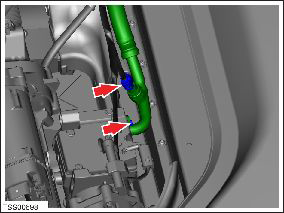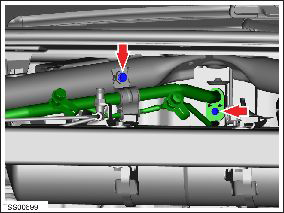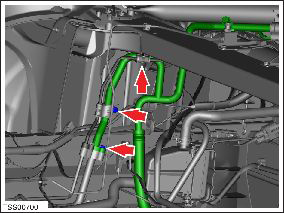Tesla Model S: Pipe - Low Pressure - Charge Port (Remove and Replace)
Tesla Model S (2012-2025) Service Manual / Thermal Management / Pipe - Low Pressure - Charge Port (Remove and Replace)
Removal
- Recover refrigerant from the vehicle (refer to procedure).
- Remove the underhood storage unit (refer to procedure).
- Disconnect the low pressure temperature transducer connector.
- Remove the bolt that secures the low pressure pipe to the
compressor (torque 15 Nm).

- Remove the nut that secures the pipe retaining plate to the evaporator TXV (torque 6 Nm).
- Remove the bolt that secures the A/C pipe bracket to the
cross-brace (torque 6 Nm).

- Release the low pressure charge port pipe from the bracket.
- Remove the bolt that secures the low pressure charge port pipe at the union to the low pressure chiller pipe (torque 8 Nm). Caution: Plug pipe connections to prevent ingress of moisture or dirt. Caution: Remove and discard O-rings.
- Remove the bolts (x2) that secure the A/C pipe brackets to the
crossmember and the RH shock tower (torque 6 Nm).

- Release the low pressure charge port pipe from the brackets (x2).
- Maneuver and remove the pipe.
- Installation procedure is the reverse of removal, except for the following:
- Replace the A/C pipe O-rings. Caution: Lubricate new O-rings with clean refrigerant oil.
- If the new pipe does not have a low pressure temperature transducer, install a refrigeration pressure sensor dummy plug on the vehicle-side electrical harness connector.
READ NEXT:
 Pipe - High Pressure - Charge Port (Dual Motor) (Remove and Replace)
Pipe - High Pressure - Charge Port (Dual Motor) (Remove and Replace)
Warning: If the 12V power supply is disconnected, do
not attempt to open any doors with door glass in closed position.
Failure to follow this instruction could result in door glass
shat
 Pipe - High Pressure - Gas Cool to Sub-Cool Condenser (Remove and Replace)
Pipe - High Pressure - Gas Cool to Sub-Cool Condenser (Remove and Replace)
Removal
Recover refrigerant from the vehicle (refer to procedure)
Remove front aero shield panel (refer to procedure)
Remove nuts (x2) securing inboard air conditioning link pipe to
 Pipe - Low Pressure - Chiller (Remove and Replace)
Pipe - Low Pressure - Chiller (Remove and Replace)
Removal
Recover refrigerant from the vehicle (refer to procedure)
Remove front skid plate (refer to procedure)
Remove nut (x1) securing pipe retaining plate to chiller TXV
(torque
SEE MORE:
 HV Junction Box - 1st Generation (Remove and Replace)
HV Junction Box - 1st Generation (Remove and Replace)
Warning: Only technicians who have been trained in High
Voltage Awareness are permitted to perform this procedure. Proper
personal protective equipment (PPE) and insulating HV gloves with a
minimum rating of class 00 (500V) must be worn any time a high
voltage cable is handled. Refer
 Charge Port - 3 Phase (Remove and Replace)
Charge Port - 3 Phase (Remove and Replace)
Note: This procedure describes how to remove and install
the 3 phase charge port. If the vehicle is equipped with a single
phase charge port, refer to procedure 44012202 (refer to procedure).
Warning: Only technicians who have been trained in High
Voltage Awareness are permitted to p
© 2019-2025 Copyright www.tesms.org

